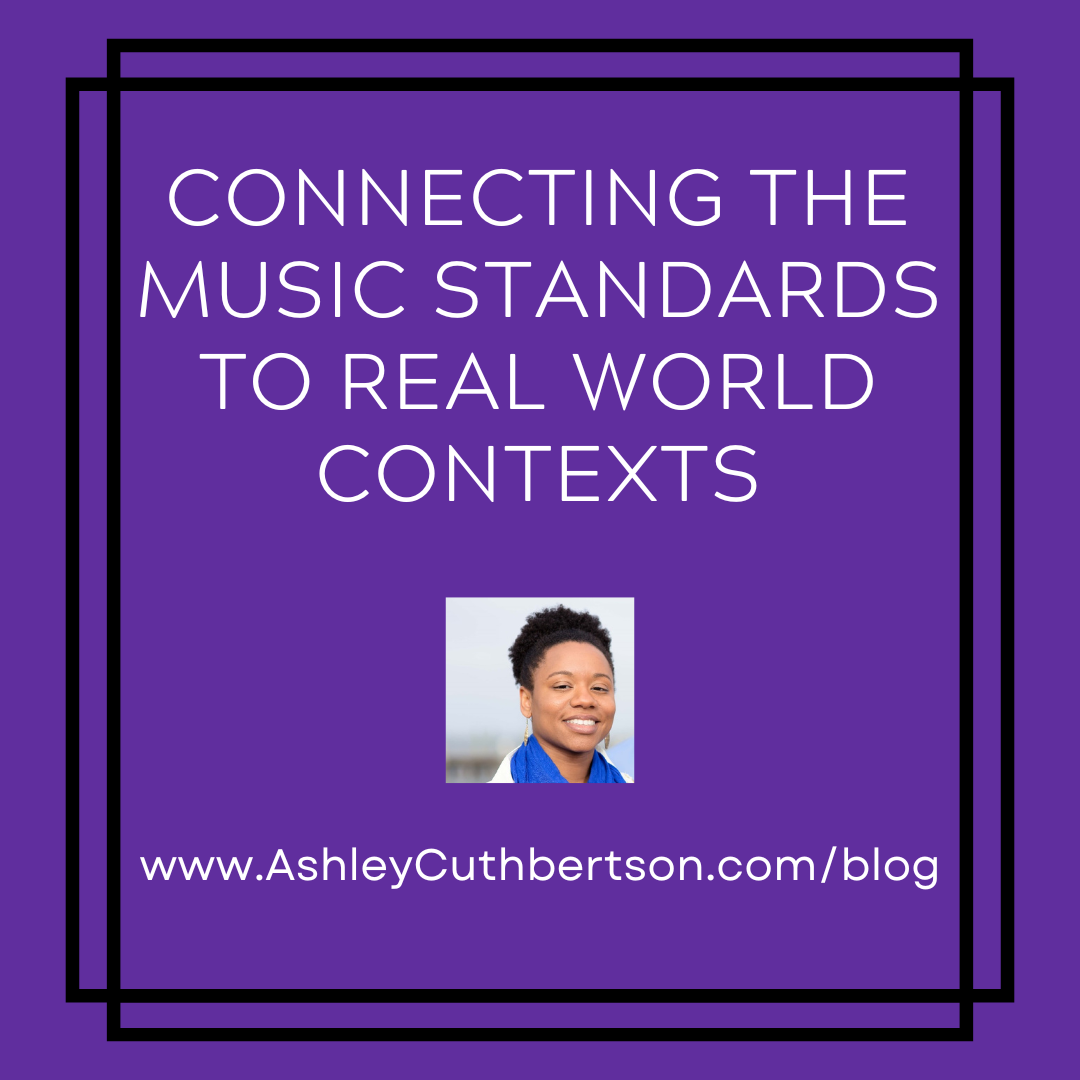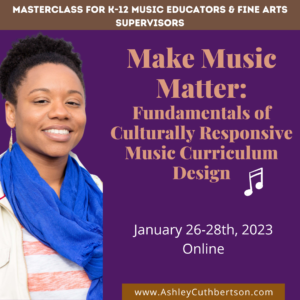Listen to this blog post by clicking the player below!
If you’ve been with me for a while, you’ve probably heard me say that “simply diversifying your repertoire is NOT culturally responsive.”
Besides the fact that you can’t just “be culturally responsive” because it’s not a thing we “do,” one issue with focusing on simply diversifying repertoire is that it doesn’t take into account the importance of the teacher making explicit and relevant connections between the curriculum and the students.
Culturally responsive music educators know that we must go beyond repertoire to engage our young musicians’ hearts and minds. We must engage students in meaningful learning tasks specifically designed to allow them to gain knowledge and skills that they can transfer into other contexts; both musical and non-musical.
As we seek to use music as a vehicle to help students advance their understandings of themselves, others, and the world around them, it’s important to keep in mind that the way we design our curriculum & instruction is a major part of how we engage our students such that we are able to help them become thoughtful & independent music makers who see the importance of music in their lives.
In today’s blog post, let’s talk about a key component of culturally responsive music curriculum design: utilizing real-world contexts of music making.
Real-World Contexts of Music Making
Traditional music teaching often leads music educators to engage in teaching and learning in ways that don’t exist outside of the school music room.
Because a key component of culturally responsive teaching is relevance, these sorts of “school-only” type ways of engaging in music cause a disconnect for our students. This disconnect serves as a barrier to our students seeing the purpose of what they’re learning and be able to engage at the level necessary for deep learning to occur.
Instead, let’s focus on how we can make what we teach inside the music classroom relevant to what students are experiencing outside the music classroom.
Making music relevant outside the four walls of our music classrooms requires us as music educators to really consider ‘why’: why would someone need to know this concept? Why would someone want to or need to know this skill?
The reality is that people are making music outside of school contexts everyday! Including your students! When we only teach music in these very school-only type contexts, we inadvertently communicate to students that there is a difference between “school music” and “out of school music.”
This disconnect between “school music” and “out of school music” is something we can easily correct when we focus music curricula on actual real-world ways that people make music and make that our focus in teaching and learning.
Start by thinking of ways that people out in the real world interact with music. Because music is a fundamental part of the human experience, there are so many ways that we all interact with music even if we’re not music educators or professional musicians.
Practical Applications: Connecting the Standards to Real-World Music Making
When considering the music standards that you use (national, state, or district), think of them as just the jumping off point. Ultimately, you as the music educator need to be able to unpack the standards to get to the heart of what they’re requiring you to teach and for your students to learn.
Additionally, as you consider the standards, you need to be able to bring them to life. This is where you connect to the real-world context of how people interact with what this standard is asking.
Here are some questions to consider as you develop the real-world contexts of the standards:
- How do people or musicians interact with this in the real-world? Why?
- What are the bigger ideas and connections that this standard could connect to?
It’s important to remember here that in making relevant, real-world connections to the standards for our students lies the purpose they need to engage at a deep level.
Let’s take a look at a few examples of standards from the National Core Arts Standards and some possible real world connections:
Standard: 1st grade, MU:CR1.1.1 (Create)
With limited guidance, create musical ideas (such as answering a musical question) for a specific purpose
Real-world context: People create music for specific purposes everyday! Consider how lullabies are songs created for the purpose of putting babies to sleep, or how work songs are created for the purpose of helping to pass the time while engaged in repetitive work.
A unit involving this standard could look like students investigating the purposes of why people make music. There are many types of songs that students could engage in as they investigate people’s motivations to create, ending with the students working through the artistic process of creating a song themselves for a specific purpose that they identify.
Standard: 7th grade, MU:Cn10.0.7 (Connect)
Demonstrate how interests, knowledge, and skills relate to personal choices and intent when creating, performing, and responding to music
Real-world context: Demonstrating interests, knowledge, and skills in regards to personal choices about music is something we all do daily! Have you ever created a playlist for a specific type of mood you wanted?
Music educators engage in this standard every time we design a concert program, however we most likely are only considering our own interests and intent and selecting specific repertoire for certain knowledge and skills we want students to gain. Instead of this very teacher centered approach to concert programming, what if we engaged our students as partners?
A concert program involving this standard could look like the teacher and students working as partners to design a concert program around a particular idea, theme, or interest. With guidance, students are the ones who make the decisions about which repertoire to program (and why) and they lead the creative choices around how the music is performed in order to evoke a desired response to convey their intent.
This is how we get to culturally responsive music education
Not by focusing on “diverse” repertoire, but instead focusing on how we can leverage music curriculum that is expressly designed to engage students in meaningful learning tasks that help them gain knowledge, understanding, and skills that they can apply in other contexts as well.
How are you designing your music curriculum to center real-world contexts of music making?
I would love to hear your thoughts on how you’re utilizing music curriculum to center real-world contexts of music making! Share in the comments below!
Also, let me know what you think of this post! If you haven’t already, be sure to sign up for my email newsletter where I send blog posts and other resources and tips each week to help support you ensure all of your young musicians thrive by centering equitable and culturally responsive practices in your music program!
Until next time,
Ashley
P.S. Did you like this post? Use the buttons below to share it with a music teacher friend!
P.P.S. If you’re looking for some support on designing culturally responsive music curriculum, here’s two ways I can support you:
- I take on a limited number of curriculum development projects each year. Send me a note here if you’re interested in me partnering with your school, district, or organization to develop music curriculum that centers culturally responsive design.
- Be sure to register for my upcoming virtual masterclass “Make Music Matter: Fundamentals of Culturally Responsive Music Design.” In this 3-part masterclass, I will take you through several key components of designing curriculum that centers culturally responsive design principles for K-12 music rooms. The masterclass is January 26th-28th, be sure to check out all the details at www.AshleyCuthbertson.com/masterclass and register today!

